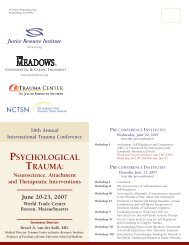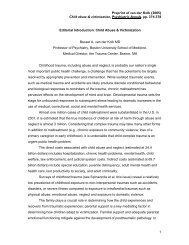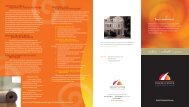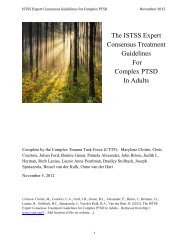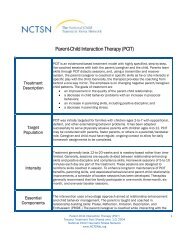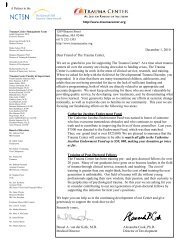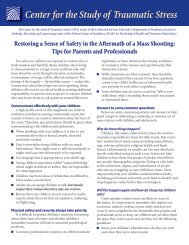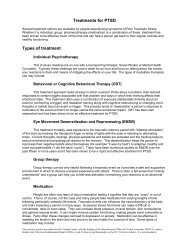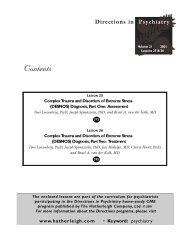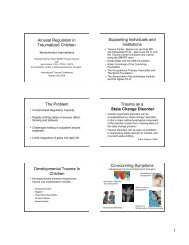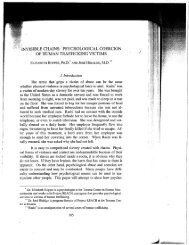in Child Welfare - The Trauma Center
in Child Welfare - The Trauma Center
in Child Welfare - The Trauma Center
You also want an ePaper? Increase the reach of your titles
YUMPU automatically turns print PDFs into web optimized ePapers that Google loves.
CW360 o <strong>Trauma</strong>-Informed <strong>Child</strong> <strong>Welfare</strong> Practice • W<strong>in</strong>ter 2013 27<strong>Trauma</strong>-Informed Care Us<strong>in</strong>g the 3-5-7 ModelDarla L. Henry, PhD, MSW, and Amelia Franck Meyer, MS, MSW, APSW, LISWAlthough there has been an <strong>in</strong>creas<strong>in</strong>g focuson “trauma-<strong>in</strong>formed care” for children <strong>in</strong>out-of-home care, for many, it has not beenclear exactly what “trauma-<strong>in</strong>formed care”means on the practice level. For example,“What do I do differently <strong>in</strong> my day-to-day<strong>in</strong>teractions with the youth?” “What do fosterparents do differently <strong>in</strong> the home?” UntilAnu Family Services (www.anufs.org) becameaware of the 3-5-7 Model © , the answersto these questions about the practice-levelchanges needed to address trauma were notas clear. <strong>The</strong> 3-5-7 Model © , <strong>in</strong> which alltreatment foster parents and social workersare tra<strong>in</strong>ed at Anu, helped to concretize howto address trauma for youth <strong>in</strong> out of homecare. <strong>The</strong> 3-5-7 Model © helped to give anew perspective to the work: trauma is theexperiences that have happened to theseyouth, losses are what they experience as aresult of these multiple and complex traumas,and griev<strong>in</strong>g is what social workers and fosterparents help them do to heal their losses andtrauma. Us<strong>in</strong>g loss as a lens by which to viewtrauma helps social workers, therapists andfoster parents to understand what needs tohappen next.<strong>The</strong> 3-5-7 Model © is a promis<strong>in</strong>g practicethat supports the work of children, youthand families <strong>in</strong> griev<strong>in</strong>g their losses andrebuild<strong>in</strong>g their relationships. <strong>The</strong> 3-5-7Model © is a strengths-based approach thatempowers children and youth to engage<strong>in</strong> activities that encourage expressions ofhurt related to losses and to give mean<strong>in</strong>g tosignificant relationships towards develop<strong>in</strong>gpermanent connections. It supports deepertherapeutic work around the traumas ofabuse, abandonment and neglect experiencesthat is or may be provided by other cl<strong>in</strong>icalprofessionals. As <strong>in</strong>dividuals beg<strong>in</strong> to reconciletheir grief, they may more readily enter <strong>in</strong>todeeper, <strong>in</strong>tensive therapies, if needed.<strong>The</strong> 3-5-7 Model © <strong>in</strong>corporates threetasks, five conceptual questions and seven<strong>in</strong>terpersonal skill elements to support thiswork. <strong>The</strong> three (3) tasks, clarification,<strong>in</strong>tegration and actualization, guide theactivities that support the work of griev<strong>in</strong>gand relationship build<strong>in</strong>g. Losses will beclarified, relationships will be <strong>in</strong>tegrated, andpermanent connections will be actualized.Clarification means to identify and makesense out of the events of the one’s life, toprovide a factual base for understand<strong>in</strong>gwhat is real and what is not real. Integrationis the process by which one develops theability to understand their connectionsand membership <strong>in</strong> numerous families.Actualization is the visualization ofpermanency, that is, the sense of feel<strong>in</strong>g safeand of belong<strong>in</strong>g, claim<strong>in</strong>g an identity, andestablish<strong>in</strong>g a place with<strong>in</strong> family or otherpermanent relationship. Actualization is wellbe<strong>in</strong>g.It is the ability of the child or youth tobeg<strong>in</strong> to see a possible permanent future witha family, parent, or guardian as the tasks ofUs<strong>in</strong>g loss as a lens by which to view trauma helps social workers,therapists and foster parents to understand what needs to happen next.clarification and <strong>in</strong>tegration are occurr<strong>in</strong>g andevolv<strong>in</strong>g.<strong>The</strong> five (5) conceptual questions, who amI, what happened to me, where am I go<strong>in</strong>g,how will I get there, and when will I know Ibelong, support the work of the three tasks.<strong>The</strong> seven (7) <strong>in</strong>terpersonal abilitiesguide the efforts of professionals, counselorsand families as they support the grief work.<strong>The</strong>se abilities are: engagement and listen<strong>in</strong>gskills, recogniz<strong>in</strong>g the pa<strong>in</strong> reflected <strong>in</strong>behaviors, affirm<strong>in</strong>g and respond<strong>in</strong>g to thesebehaviors from a grief perspective, rema<strong>in</strong><strong>in</strong>gpresent to these expressions of grief,creat<strong>in</strong>g opportunities for the perception ofsafety with<strong>in</strong> the help<strong>in</strong>g relationship, andrecogniz<strong>in</strong>g that grief work and relationshipbuild<strong>in</strong>g can be done only by those who haveexperienced the loss.<strong>The</strong> 3-5-7 Model © provides tools, basedon theoretical foundations, to support thework of the child or youth. For example:Start the activity with the child byexpla<strong>in</strong><strong>in</strong>g that you are go<strong>in</strong>g to play a specialk<strong>in</strong>d of basketball, which will help them discusshappy and sad feel<strong>in</strong>gs. When the child throwsa ball through the hoop, they select a card froma “happy face” pile. When the child misses thehoop, they select a card from a “sad face” pile.<strong>The</strong>y share their feel<strong>in</strong>gs, or not, at a pace thatis safe and comfortable for them (<strong>The</strong> 3-5-7Model © Workbook, p.16, 2012 Edition). Thisis a safe way for the child to identify and expressfeel<strong>in</strong>gs and typifies the task of clarification bysupport<strong>in</strong>g them <strong>in</strong> tell<strong>in</strong>g the story of events thathave happened to them. Questions related toidentity and griev<strong>in</strong>g are captured <strong>in</strong> this work.Through learn<strong>in</strong>g the techniques andtheories of the 3-5-7 Model © , workersand families become knowledgeable andcomfortable <strong>in</strong> explor<strong>in</strong>g the hurts of thosethey parent and work with, learn<strong>in</strong>g patienceto support the expressions of their pa<strong>in</strong>. Asa practice for relational work, the use of thismodel has shown that children and youthdo their work <strong>in</strong> griev<strong>in</strong>g losses and are ableto move forward towards permanency <strong>in</strong>relationships where they feel safe and secure.Darla L. Henry, PhD, MSW, MARS, isthe author of the 3-5-7 Model©, 3-5-7Model© LLC. She can be reached atdhenry@darlahenry.org.Amelia Franck Meyer, MS, MSW, APSW,LISW, is the CEO of Anu Family Services.She can be reached at afranckmeyer@anufs.org.Practice




